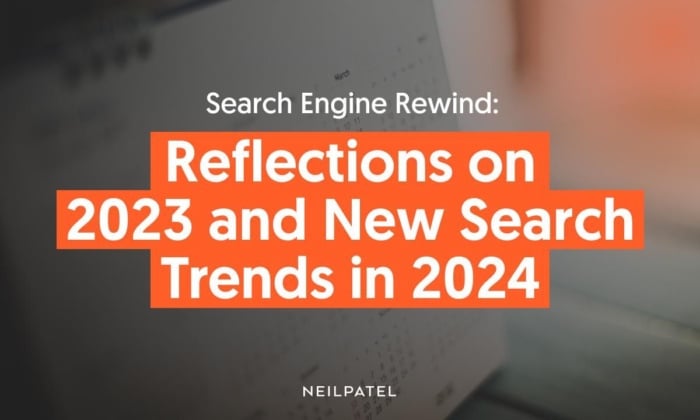
Companies that ignore marketing trends may leave thousands (or millions) of dollars on the table.
For some marketing pros and SEOs, that’s what happens. A specific algorithm update doesn’t seem like a big deal. There’s not enough budget to invest in video. The CMO doesn’t think AI poses a big risk to their existing strategy. Maybe someone in the C-suite has never heard of the sunk cost fallacy.
These things happen.
But trends matter. Staying ahead of the curve matters. And in search, where a single moment’s hesitation can set you back months, you need to be proactive—not responsive.
This isn’t just a Google thing, either. Understanding these trends and the strategies to take advantage of them applies to other engines like Bing, Naver, Baidu, Yandex, and others.
With that in mind, here’s a look back at some big trends—from continued AI growth to the Search Generative Experience (SGE)—that made 2023 a wild year in search and the things that will make huge waves in 2024. If you want to see even more insights on how things are trending, be sure to check out the full report here.
Search Engine Trend Essentials
Key Points:
- A glut of AI content is causing Google to make changes to stay ahead, including using the Search Generative Experience (SGE) to deliver zero-click answers to user queries.
- Short-form videos are now extending well beyond TikTok to grab user attention.
- Visual search with new gadgets like Apple Vision Pro and existing tools like Google Lens are powerful ways to make yourself known. Optimize your images accordingly.
- Global SEO tactics are a powerful tool for reaching audiences who don’t speak English. Leverage those opportunities.
- A neighborhood focus on hyperlocal SEO is an essential way to meet your customers where they are.
- All content may not be king anymore, but good content is still a top priority.
Table of Contents
- AI Is Here to Stay, and Changed Everything We Know
- 2023 Google Algorithm Updates and Their Impact
- Video Is Still Essential (But Changing)
- The Second Wave of Voice and Visual Search
- You Should Be Planning for SGE Already
- Consider SEO Opportunities Outside of English
- Hyperlocal SEO Is in the Spotlight
- Content Isn’t King Anymore (But It Is Relevant)
- Social SEO Is Taking Up a Bigger Search Share
- Conclusion
What Search Engine Trends Shaped 2023?
Each year sees new trends and priorities for SEOs, and 2023 certainly brought a ton of changes.
The influx of AI-driven and produced content has led to some cracks in the impenetrable dominance of Google, especially in regard to quality.
Even if the original “pivot to video” didn’t pan out, video itself is still an engaging medium essential to content strategy. But how companies use that video content is important.
Thinking about your brand is a big part of marketing, too, and it’s especially critical for companies with intense competition. Imitation may be the sincerest form of flattery. But as AI makes it easier for your competitors to copy you, you’ll need to use omnichannel marketing to stand out.
Finally, thinking about leveraging voice and visual search is one trend marketers may have neglected—especially with AI innovations front and center—but it still played a big part in 2023’s marketing trends.
AI Is Here to Stay, and Changed Everything We Know
Unsurprisingly, one of the biggest stories in search and content marketing for 2023 continued to be widespread AI adoption among marketers (and search engines). But just how big was it?
In a study NP Digital performed in March 2023, 50% of marketers said they were already using AI or planning on using it soon. When the agency asked that same question later in the year, that number jumped to 65%.
Sure, knowing how many people use AI is great. But you also need to look at how those marketers implement AI tools in their workflow. NP Digital can’t speak for everyone, but some of the most popular ways to integrate AI include the following:
- Writing metadata
- Generating content ideas and fleshing out outlines
- Categorizing keywords
- Generating FAQ content
When using AI tools like ChatGPT, Gemini (formerly Bard), Jasper, or Claude, one key thing to remember is that AI’s a helper—not a replacement. You can’t use it to create 100% of your content, even if it feels faster (and costs less).
Why?
Well, the performance just isn’t there. Even if an AI takes 16 minutes to write content instead of the hour it would take a human writer, you won’t make up that difference in performance. When NP Digital recently compared a piece of content generated by an AI to one written by a human, the results spoke for themselves.
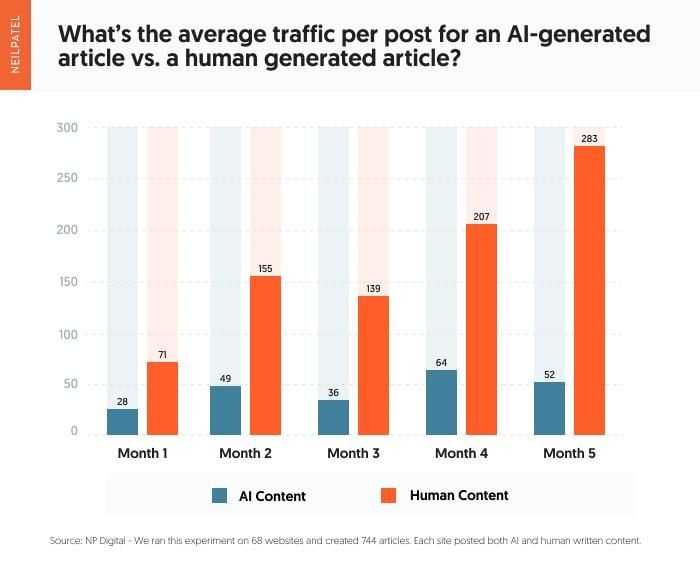
Within five months, the human-generated content produced more than five times the traffic on a monthly basis.
Austin Cosler, Managing Editor at NP Digital, breaks down some of the current flaws with AI tools:
“AI often hallucinates, defaults to crutch words or cliches, repeats ideas unnecessarily, or misses the mark on our target tone and voice. The list of output issues goes on. While the future capabilities of generative AI are unknown, human creativity, empathy, discretion, and expertise remain vital when addressing AI output quality.”
With that said, he also notes that there are a variety of effective ways to use AI, including:
- Ideating new and creative content topics
- Conducting subject matter research
- Creating robust outlines
- Preventing writer’s block
The widespread adoption of AI has a notable drawback, however. The heavy influx of AI content has resulted in a glut of low-quality content crowding out top positions in the SERP. Search engines like Google and audiences alike have used different means to filter out AI content already found elsewhere.
The solution for marketers with an eye toward content strategy is simple: Offer new perspectives and content that engages with users’ needs, not content for content’s sake.
We also shouldn’t ignore the applications of AI outside of content generation.
Chris Coomer, Vice President of Data, Analytics and Insights (DAI) at NP Accel, explains that:
“AI allows us to evaluate data sets much faster, allows us to evaluate patterns that are complex, and gives us a head start to ensure our clients are making the best strategic decisions. Actionable Insights are positive impacts on goals based on data analytics and insights.”
2023 Google Algorithm Updates and Their Impact
It wouldn’t be a search trends update without Google algorithm updates, and 2023 was no exception.
Google put out four core updates in 2023, with two happening back to back at the year’s end. These occurred in March, August, October, and November, with the intention of improving the algorithm to bring the user more relevant content for their query. With the exception of the November 2023 update, which took 26 days to complete, most occurred within roughly two weeks.
Each update introduced incredible search volatility, especially since the core updates overlapped with smaller updates.
While we don’t have a full understanding of exactly why each core update changed, we have seen a large drop for many sites, especially smaller publishers in terms of visibility in the second part of 2023. This occurred to the point that Google has given the word that changes are still coming.
In addition to core updates, Google made algorithm changes to its reviews program. The three reviews updates in February, April, and November expanded beyond product reviews, including those for businesses, destinations, media, and other content. The end result here appears to be a smaller presence for review-based content outside of review-oriented searches.
Another significant update that had major impacts? The August changes to FAQ structured data and HowTo rich results. It was noticeable enough that a study from NP Digital indicated heavy drops in visibility and FAQ-related clicks after the update.
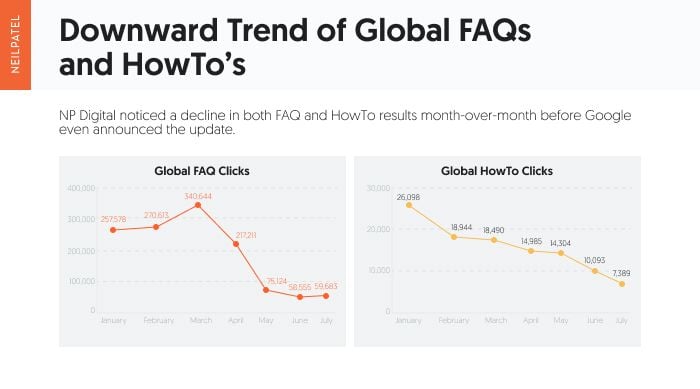
Finally, Google introduced a heavyweight Helpful Content Update in September, creating a lot of volatility. The idea behind this update was to put more emphasis on satisfying website experiences, including emphasizing content made for humans over search engines. Websites that saw a substantial decline in content performance might have experienced it for a few reasons, including:
- Heavy reliance on overt SEO tactics versus real-world experience or authoritativeness
- A focus on monetization instead of user value
- Lack of content originality
- “Fluff” content that no one would read before answering actual search queries
Google’s algorithm updates changed the game in 2023, and it looks like 2024 will be similar, starting with the March 2024 Core Spam Update. This is designed to reduce low-quality content and spam in SERPs, combating the flood of AI-generated content.
As the algorithm continues to shift, NP Digital works to put our clients in the best position possible here by focusing on quality, helpful content, as we always have. While the specific approach to SERP success is going to vary by each client and their audience, focusing on relevant queries and useful content is something that is always valuable.
Video Is Still Essential (But Changing)
Video continued to be a significant component of successful marketing in 2023, and it’s still important. But which types of video do best? Is it still worth investing in TikTok or YouTube Shorts?
Well, short-form video was the most successful content type on social media, and by a wide margin. NP Digital analyzed more than 6.3 million posts on social media and discovered that 31.38% included some form of short video.
The average user spends 95 minutes each day watching short-form videos on TikTok. That speaks to the trend of platforms pushing shorter videos across all platforms.
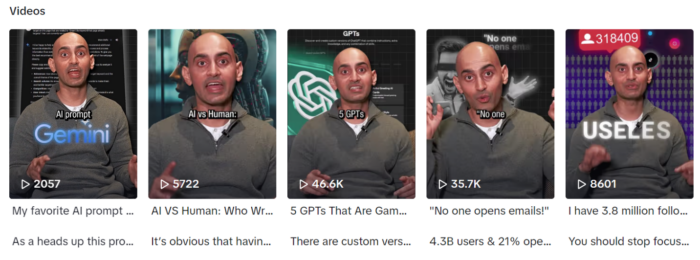
What’s driving this trend? Kayla Bautista, Social Media Manager at NP Digital, notes:
“Short-form videos serve as an effective method for delivering instant entertainment and information, making them highly shareable and conducive to viral engagement. Short-form videos also provide an engaging way for brands to connect with their audience and showcase products or services.”
That doesn’t mean you should abandon efforts to create longer videos or content featuring interviews. You just have to ensure it fits your audience and has appropriate production values. As video content becomes much more common, audiences develop higher standards. Good visual design, effective editing, and accurate captions are just as much a part of what these viewers value as the message itself.
There’s one final technical note on video content: Google has changed the way it indexes videos. If it’s not a page’s main content, it won’t be featured as a rich result on the SERP.
Branding and Community Marketing Are More Important Than Ever
Last year, NP Digital mentioned that branding and success intertwine. The advent of AI makes this even more important.
As technology advances and streamlines content creation, copying the competition is easier. But that’s not the way to succeed. Instead, think about the smart brands—the Disneys, Starbucks, Apples, and Amazons—that sell more than products. They sell feelings. Making your brand stand out and resonate with consumers is a far more powerful tool than simply lifting content, imagery, and messaging from your competitors.
Consider Dove’s standout big game commercial, Hard Knocks. This brief 30-second ad highlighted the importance of inspiring people to help girls stay in sports. It’s an emotional appeal on the world’s biggest stage:
One great way to leverage your brand is to integrate into your omnichannel marketing strategy. When you meet your potential audience(s) where they might be, synergy among channels can help you get more engagement. Just be sure your content is consistent across the brand.
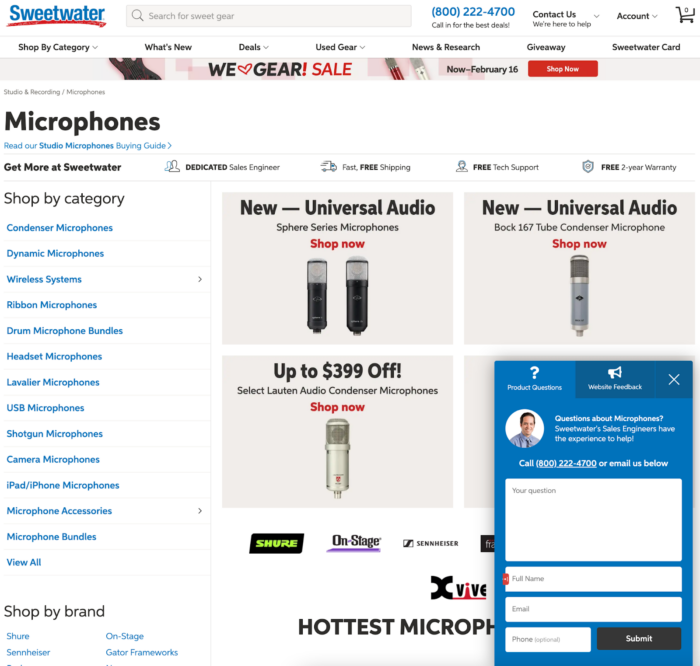
As Shopify points out in its guide to great omnichannel marketing among retailers, music retailer Sweetwater offers a buying guide for the products you’re shopping at the top of its page, a product question form that allows you to chat with sales engineers, and excellent customer service throughout the buying journey.
If you need help putting your brand front and center, consider increasing visibility and credibility by engaging in practices like guest posting. If it’s not something you’ve done for a while, it can breathe fresh air into your branding strategy.
The Second Wave of Voice and Visual Search
Search trends have focused so far on traditional text-based search results and video, but voice and visual search have seen some significant advancements recently. And it really all ties back to AI and language learning.
Conversational AI advancements allow for more comprehensive voice searches. For marketers, that might mean targeting potential keyword optimizations that previously may have felt out of reach. Consider thinking about long-tail keywords and natural language, like questions. For example, a user might ask their smart assistant “What time do the New York Yankees play on Tuesday?” or “How often should I change the oil in my 2022 Toyota Camry?”
Structured data markup makes it easier for voice assistants to understand information and deliver accurate, detailed answers to search queries. That could even open up sharing audio content from podcasts, as voice assistants can access that audio.
In addition to voice search, visual search has seen and will likely see exciting developments. Consider devices like the Apple Vision Pro and how it can present new opportunities to gain results. Searching for products based on items people see in their houses and store shelves might be even more accessible.
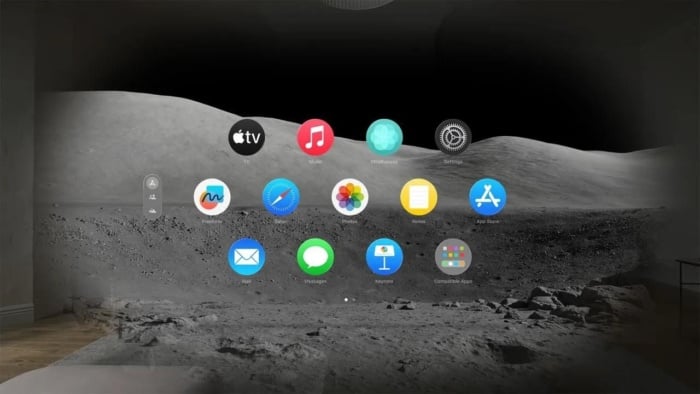
How can marketers capitalize on improvements in visual search? The same way they always have: optimized images that are clear enough to see but fast enough to load promptly on mobile and writing alt text that makes those images more recognizable to search engines.
The Search Engine Trends That Will Shape 2024
If 2023 brought seismic shifts in how marketers approach their work, what can we expect for 2024?
While Search Generative Experience (SGE) is the most significant development search marketers are anticipating, there are still other trends to look out for, especially in the local SEO space. SEO experts must develop a “hyperlocal” mindset as consumers focus on what’s near them at a neighborhood—not citywide—level. In addition, there’s an opportunity for growth in SEO opportunities outside of the English language.
Ultimately, the biggest priority for marketers is to become proactive instead of reactive. We all know how long it takes for changes to take hold after implementation. Playing the waiting game could leave you in the dust.
You Should Be Planning for SGE Already
NP Digital has talked about SGE in the past, but it’s really impossible to overstate just how seismic a shift it will have on the industry. That’s why it was a little surprising that a November 2023 survey of 1,000 revealed that just under 50% of the surveyed marketers didn’t have a fully finalized strategy for SGE.
It’s a big deal! That hesitation has already put them behind.
SGE is a major leap forward for zero-click content designed to answer user questions through Google without clicking on an actual page. And while SGE isn’t intended to answer every question under the sun, it can still provide helpful insights and information in this zero-click context.
Matthew Santos, Senior Vice President of Product and Strategy at NP Accel, notes:
“At the SMB (small- to medium-size business) level, I think this is a new feature that gives the little guys a fighting chance of finally showing up above the fold on short-tail queries. 94% of the SGE section results are completely different from the organic 10 blue links below it. So, to me, it shows that Google is hungry for new brands to come onto the scene and grab some market share.”
SGE is very much a work in progress, though. Unfortunately, accuracy can be a struggle, given the rise of AI-driven content (and self-cannibalization). But over 65% of the marketers surveyed by NP Digital don’t feel that way. In fact, many of them thought it’d be more accurate than conventional results.
How can you build a strategy to put your content front and center in AI experiences like SGE?
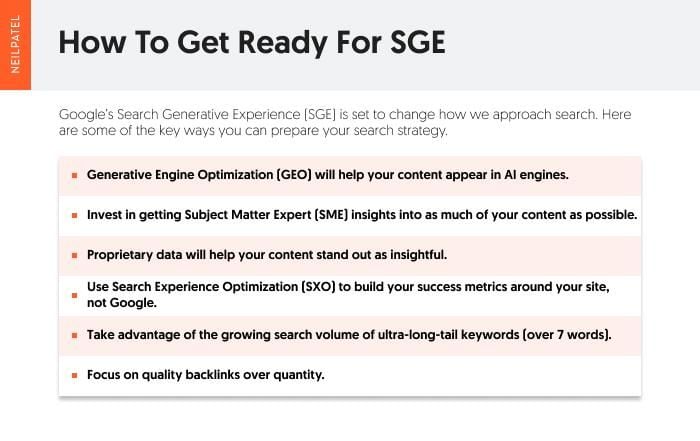
Focus on generative engine optimization (GEO). Diversify your strategy beyond the basics of SEO. Include time to value in your articles and posts, and don’t forget to emphasize a good user experience (UX) as part of your decision-making. Getting your content mentioned across the web helps bolster your authority and promotes you as a reliable source.
Where have you heard that before? Oh, yeah: E-E-A-T.
Some of the best ways to focus on E-E-A-T include ensuring you have author pages that show your writers know what they’re talking about. In addition, you should make a concrete effort to include subject matter experts (SMEs) in every piece of content you produce.
In addition to GEO, there’s another optimization tactic you should focus on: search experience optimization (SXO). SXO prioritizes success metrics like conversions or lead generation based on your site’s metrics, not Google’s.
Finally, reconsider any preexisting notions about ultra-long-tail-keywords with seven or more words. In 2023, those types of keywords drove an increasing amount of revenue compared with years past.
The Future of Link Building
You can’t talk about SGE without talking about link building.
Earning links helps Google understand that your content is worth paying attention to, but how you build those links is different. Your priorities should now include things like:
- A better focus on quality over quantity links, either through cultivating good ones or manually disavowing spammy or low-quality ones.
- Asset formats that will help you earn links, like quizzes.
- Focusing on data and figures that will appeal to publishers and major sites (a cornerstone of your digital public relations (DPR) strategy)
- Using AI and machine learning to help with outreach and relationship management.
Consider SEO Opportunities Outside of English
Nearly 59% of content online is in English.
But there’s a problem with this: Most of the world doesn’t speak the language.
However, every problem comes with a big chance to score a win. And for SEOs, that means targeting SEO opportunities in other languages. While many major companies already do this, mid-size and startup organizations should start. One effective strategy is to localize (not just translate) effective content on your site into different languages. You can also optimize your website architecture for multiple languages. And if you need help identifying markets where multilingual SEO makes sense, consider using your analytics platform to investigate where your users are coming from.
In 2024, NP Digital will take global SEO opportunities to heart as it continues expanding internationally.
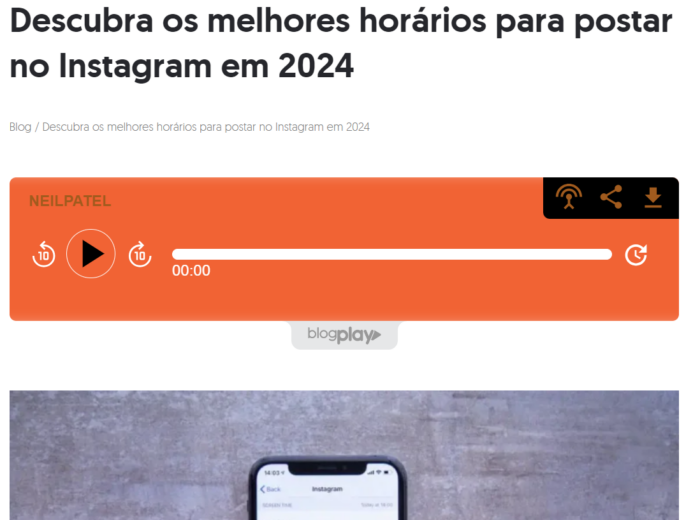
That’s not just good for the agency. It’s good for their clients, too, as the agency continues to rack up awards from industry-leading publications like The Drum.
Hyperlocal SEO Is in the Spotlight
Local SEO has always been important, especially for industries that serve customers at multiple locations. But now, it’s becoming a critical part of all marketers’ strategies. Instead of focusing on SEO for a market or city, consider the idea of hyperlocal SEO.
What is hyperlocal SEO? The strategy drills down to specific neighborhoods and localities instead of cities or metropolitan areas. The days of “restaurants in my city” might be over. Instead, the search might include specific street names, subdivisions, suburbs, and ZIP codes.
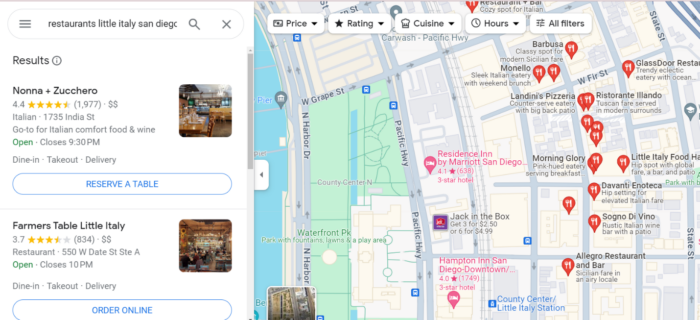
How can you be proactive and anticipate this shift? Easy: Start thinking about geotargeted keywords to connect with local searchers. Optimize your pages for terms that contain city names, neighborhoods, and distances.
That hyperlocal focus should extend to regular updates to your Google Business Profile and Apple Maps pages. Ensure information is accurate. Don’t forget about social media, either. Your name, address, and phone number should always be correct. Regular audits go a long way toward ensuring your next customer can find you.
Content Isn’t King Anymore (But It Is Relevant)
Let’s talk about content.
If there’s one part of the marketing world that is particularly shaken up by AI, it’s content creation. AI-generated content is practically everywhere, and it’s challenging some of the conventional wisdom.
The prevailing wisdom used to say that “content is king,” but that adage comes from a time when there was a lot less of it available. These days, writers and marketers produce nearly 4.6 billion pieces of content each day.
Does that mean blogging isn’t worth the effort? Absolutely not. It’s just more challenging to stand out. If you’re not standing out, you might not see the return on investment (ROI) you want. After all, over 96% of the content indexed in Google sees no meaningful search traffic.
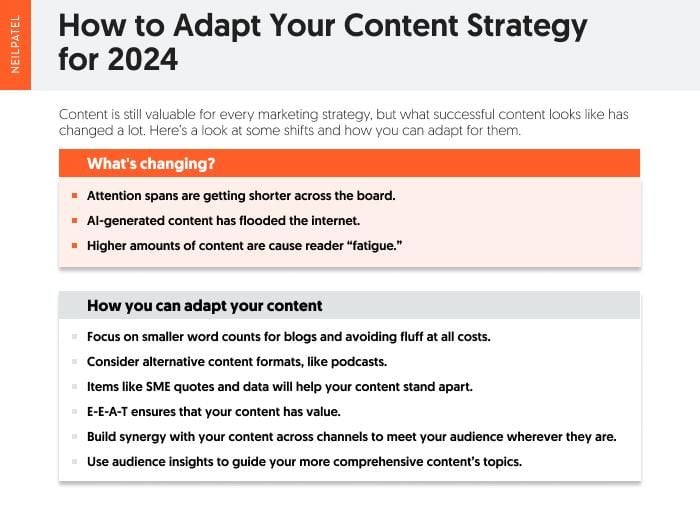
So, how do you manage the issue?
The same way you always have, just dialed up to 11: Create unique, fresh content surrounded by a good UX, then promote it effectively.
Great content these days might focus less on passive consumption and more on interactive elements like demos, quizzes, and augmented reality (remember the Apple Vision Pro?).
Attention spans are shorter. The “TikTokification” of online video has emphasized smaller content, especially when you have a short amount of time to get your point across. That translates to text content, too.
Smaller word counts that get your point across faster might be a lot more powerful than 5,000-word deep dives.
Kim Scoppetta, Senior Director of Content at NP Accel, points out that:
“No matter the topic complexity, what matters is readability. Use bullet points, TLDRs, and visuals to get your point across. Don’t try to infuse marketing jargon—stick to the topic at hand and give readers the information they came to you to learn.”
If blogging isn’t your thing, consider podcasting. There are over a billion blogs out there versus between 3.2 million and 4.3 million podcasts. And while those are still huge numbers, it makes podcasts a much easier medium to impact. You still have put out a quality product, though.
Ultimately, you need to put effort into your content, which might need a different focus than the traditional text medium of years past.
Social SEO Is Taking Up a Bigger Search Share
In last year’s recap, NP Digital talked about how social media platforms like TikTok are turning into new, more popular search platforms. That’s still true. You’ve probably even noticed that social media posts on platforms like X, TikTok, and other networks are taking up a larger share of high search results.
What this means for marketers is that including social SEO considerations and optimizations needs to be a part of content creation for social posts. In practice, this looks like:
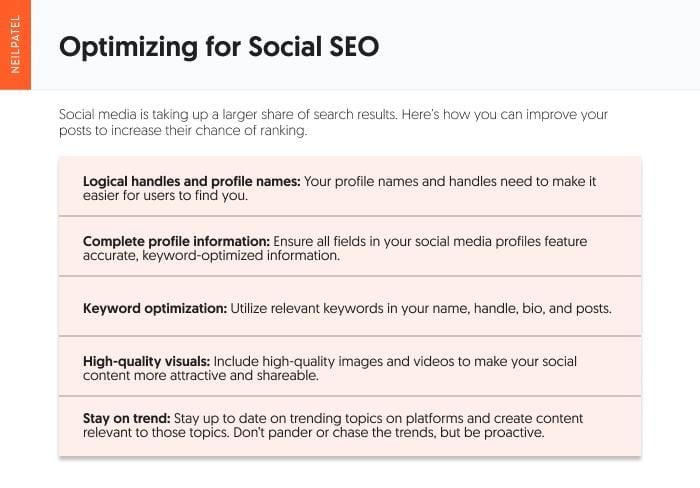
Kayla Bautista adds,
“It’s important to create content that is not only visually appealing and compelling but also informative and valuable to users searching for specific topics or solutions. As a result, brands need to find a balance between creating content that resonates with their social media followers and aligns with the broader search intent of online users.”
Conclusion
There are still a lot of unknowns in search trends for 2024, especially given how long it is taking for SGE to roll out. But that doesn’t mean you can’t proactively prepare for them or make efforts to adopt the strategies outlined above.
Marketers looking at where SEO is headed in 2024 should clearly be thinking about how content volume isn’t as important as content quality. While you should still keep a regular cadence, the influx of AI-generated content means shorter, quality content is at a premium.
As more brands rely on AI to pump out content, building your brand is more important than ever before, as is consistent messaging across all channels.
Finally, don’t underestimate the importance of global SEO outreach, especially if you have customers who don’t speak English or live abroad.
If you’re feeling less than confident about your ability to leverage these strategies or trends, why not partner with someone who can? Reach out for a consultation with the NP Digital team today.

See How My Agency Can Drive More Traffic to Your Website
- SEO - unlock more SEO traffic. See real results.
- Content Marketing - our team creates epic content that will get shared, get links, and attract traffic.
- Paid Media - effective paid strategies with clear ROI.

Unlock Thousands of Keywords with Ubersuggest
Ready to Outrank Your Competitors?
- Find long-tail keywords with High ROI
- Find 1000s of keywords instantly
- Turn searches into visits and conversions
Free keyword research tool
